SEO for Manufacturing: What You Need to Know
B2B buyers once were loath to buy manufacturing products online. But all that’s changed, according to research of more than 100 B2B buyers, by Master B2B. Half of all buyers say they bought more online in 2023 than in 2022. And for 2024, 82% projected they’ll be buying online.
That’s great news for manufacturers — if their products can be found.
One of the biggest challenges cited by manufacturers is that their products aren’t findable by search engines. To combat this, a comprehensive search engine optimization (SEO) strategy is necessary.
But if your company is like most manufacturers, it probably was slow to embrace digital marketing. If you are a content marketer, that puts you in a precarious spot.
This post will help content marketers create that SEO strategy that every manufacturer sorely needs — and provide best practices for getting it done.
Why SEO Is Necessary for Manufacturing
In Master B2B’s 2023 State of B2B Buyer Report, 27% of manufacturing parts buyers said they switched to buying online to save time. Other reasons respondents cited were to get more and better information on products and services (21%). For 24/7 website access (20%). And online purchases are easier to track for record-keeping purposes (16%). Only 13% said it was to save money.
The shift in buyer behavior is undeniable, and if you want your manufacturing company to thrive, you must recognize the opportunities that digital marketing presents. By focusing on creating a comprehensive online buyer’s journey, you not only address your customers’ needs but also stay ahead of the competition.
Firms that invest in a great search engine optimization strategy will find that they can make it easier for customers and prospects to find you online. Why does that matter? Because today’s prospects are far more educated about buying than ever. With over 100,000 searches performed on Google every second, customers have done their homework long before connecting with your business. Thus, the dynamic between prospects and sales/marketing has significantly changed.
SEO for Manufacturing Companies in Action
To see how this works in real life, let’s use injection molding as an example. Every month, approximately 12,000 people in the US type this search term into Google and here’s what they see.

Looking at the full search engine results page (SERP), you’ll see a lot of information served using different types of content. There are:
- Google Ads
- Knowledge panels
- Organic listings (web pages with titles and descriptions)
- Other questions people often ask in connection with this search term
- Books
- Places (based on your location)
- Top news stories
- Images
- Additional related searches
Injection molding is a hot topic in manufacturing, and there are many reasons why product engineers would search using this term.
By the way, the reasons why are what SEOs refer to as search intent or the intention behind the search. For example, if people are searching for “what it is” – then they aren’t intending to buy. Their intention is to learn. But if their search is “Best Injection Mold Materials” – ah, now they are showing intention to consider purchasing.Google serves up a variety of different content for this search query to try and satisfy that intent. That means there’s an opportunity for a page on your website to appear in this result. However, this also applies to your competitors. And given that people don’t venture past the first page of search results, the competition can be pretty intense. Despite this, the rewards can be significant.
How Manufacturing SEO Benefits Your Business
When people have a question or need to conduct research, they’re likely to turn to Google. Your ability to appear as a search result, at their time of need, can make a huge difference.
In our webinar, Driving Brand Growth: Effective Storytelling through Content, MarketMuse co-founder Jeff Coyle refers to a quote by Gong (a sales software company) saying that “competitive deals are won early, when the battle ground is still fertile” and that they’re won with “discovery techniques and not closing techniques.”
Early in the buyer’s journey, when people are looking for information, as opposed to purchasing something, 75% are more likely to click on an organic listing in the search results versus an ad. This is the perfect opportunity to shape the narrative surrounding your manufacturing company.
Buying Google ads is the easiest way to guarantee the first page – however, that costs money. Also, incorporate SEO into your digital strategy.
Incorporating SEO Into Your Digital Marketing Strategy
Your digital marketing strategy boils down to drawing website traffic to your brand, educating them through content, and then capturing and converting prospects. Adhering to SEO best practices turns your site into a digital marketing machine. Here’s how.
Search engine optimization requires a careful orchestration of onsite and offsite activities. Onsite activities boil down to technical SEO and content creation, whereas off-page SEO includes link building on high-authority sites.
Technical SEO ensures that search engines can index the pages on your website. Some issues that impact ranking are site architecture and page load time. Too many applets on your site or uncompressed images will slow down your site. Google doesn’t like latency, and guess what? Neither do your visitors.
The goal of technical SEO is to ensure your site can be crawled and indexed by Google. Because if search engines can’t discover your pages, they can’t rank.
But all your SEO efforts will be in vain if you don’t produce quality content – relevant material that matches what searchers are looking for.
Topic Research, Content Creation and Optimization
Once upon a time, people called it keyword research, but Topic Research. A keyword is the word or phrase used to search. A topic is the context behind that search. So Topic research is crucial for SEO because it looks at what exactly your target audience is interested in.
SEO encourages the creation of high-quality, valuable content that aligns with user search intent. Make sure you incorporate a lexicon that shows your expertise. For example, if you are writing on the topic GenAI in Marketing – you would want to use vocabulary like content creation, machine learning, artificial intelligence, semantic analysis.
All your SEO efforts are in vain if you don’t produce quality content – relevant material that matches what searchers are looking for. That’s the search intent we talked about earlier. And as you continue to consistently produce helpful content around your subject of expertise, you’ll develop authority in the eyes of Google.
MarketMuse provides a terrific breakdown of the vocabulary you need to use in your content to win any given topic.
On-Page SEO Tactics
It’s not just content that needs to be optimized — it’s the page elements, too. Optimize all the various on-page elements, such as meta tags, headings, URLs, and image tags, and pay attention to alt tags. Alt-tags tell the search engine that you have optimized for accessibility.
Off-Page SEO Tactics
Google ranks by popularity – or authority – and nothing says authority like having a site link back to you. Getting backlinks is hard – but is a crucial part of off page seo tactics. Customers, vendors, media outlets, and conferences will supply back links – but have to be part of an outreach strategy.
User Experience Improvement and Technical SEO
In figure skating, you get judged by style — and technical. Same with SEO. As noted before, make sure your site is responsive to mobile; isn’t slow, offers alt-tags for visually impaired or hearing impaired visitors, and doesn’t have broken links.
The goal of technical SEO is to ensure your site can be crawled and indexed by Google. Because if search engines can’t discover your pages, they can’t rank. But all your SEO efforts will be in vain if you don’t produce quality content — relevant material that matches what searchers are looking for. That’s the search intent we talked about earlier. And as you continue to consistently produce helpful content around your subject of expertise, you’ll develop authority in the eyes of Google.
Websites that aren’t mobile-friendly are difficult to interact with. Page speed is another important factor. According to Google, “For every second delay in mobile page load, conversions can fall by up to 20%.” A potential customer visiting your slow site is unlikely to take the next step to becoming a buyer. Once again, Google has some free tools for checking page speed.
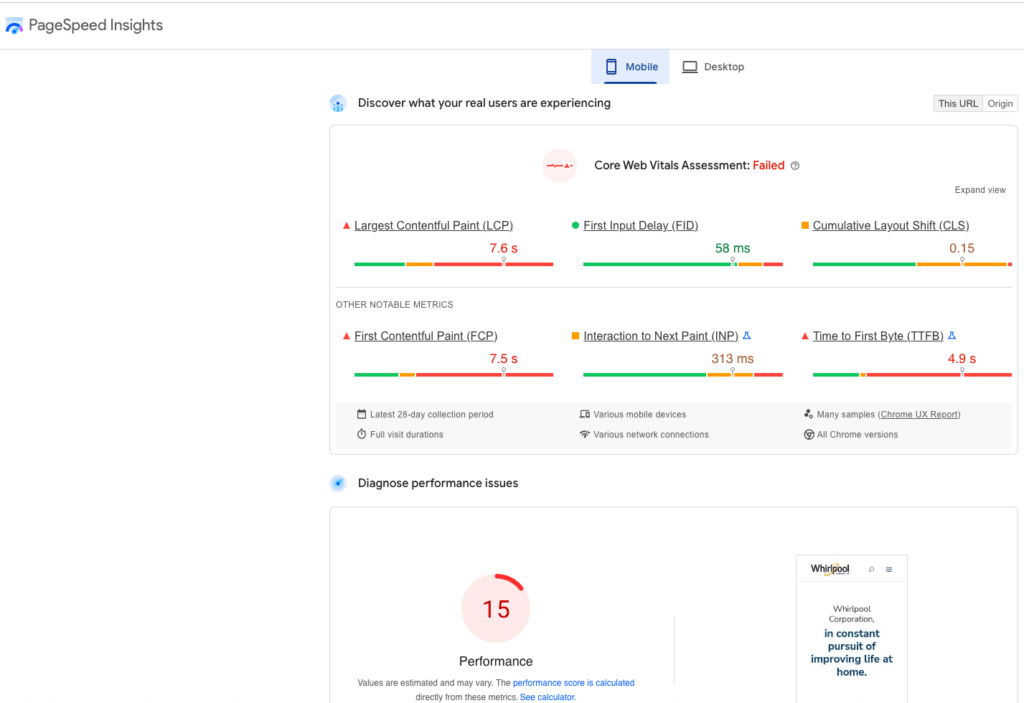
Helpful Content
Content that’s well optimized is one thing – but it also needs to be helpful. This is a term Google has recently started using in conjunction with their “helpful content update” that rolled out in September 2022. It’s all about focusing on people-first content as opposed to that created primarily for search engines.
For a manufacturing company, having all the details readily available for users to make a buying decision — including product details, manufacturing specs, images, and how to videos. The purpose is to guide someone all the way down the marketing funnel to becoming a customer.
MarketMuse patented modeling technology provides a list of related topics ordered by relevance along with content length, and content scoring. Use this as a guide to creating the most comprehensive content.
SEO Tips With MarketMuse
Search engine optimization is a deep and complex subject affecting many aspects of your online presence. While the following information won’t turn you into an SEO expert, it will give you a basic understanding of the role it plays in your content marketing activities.
Employ Good Web Design
Poor website design can significantly impact your ability to rank and convert potential clients. Even if you’re not directly selling from your website, it should at least generate leads. If your website looks like it was designed last century, it’s time for an update! That means making it mobile-friendly and making it fast. Mobile-friendliness is important to Google, so it should matter to you, from an SEO perspective. Fortunately, Google Search Console makes it easy to check if your site has any issues in this regard. But you can do a quick visual check yourself to see if it looks something like this. It’s hard to read because of the small fonts which also makes it hard to click on any links.

Be Careful With Topic Research
Topic research is the basis for content creation and most often relies on a combination of search volume (the popularity of a search term) and keyword difficulty (the perceived difficulty of ranking). Instead of creating content with an eye to progress down the marketing funnel, it gets created based on website traffic volume and the ease of which that content can be ranked. I’ve written extensively keyword search volume and keyword difficulty in the past, but if I could sum it up into one sentence, it would be this:
Content created using the keyword volume/difficulty matrix creates a fragmented experience where you leave prospects hanging instead of leading them on a journey.
By the way, MarketMuse can help with providing the right data centered around decision-making. Using predictive ROI, you’ll know how much content to create and update, and on what topics. Plus, you’ll refine your planning — cluster creation, owning a topic (what and how much needs to be created/updated), and prioritizing those efforts.
Recycle, Refresh, and Republish
In theory, the more content you have, the more opportunity you have to rank. But it’s tough to keep up the pace. Think in terms of recycling, refreshing, and republishing existing content. This will help you keep the older items fresh and relevant, and will help you maintain a publishing cadence.

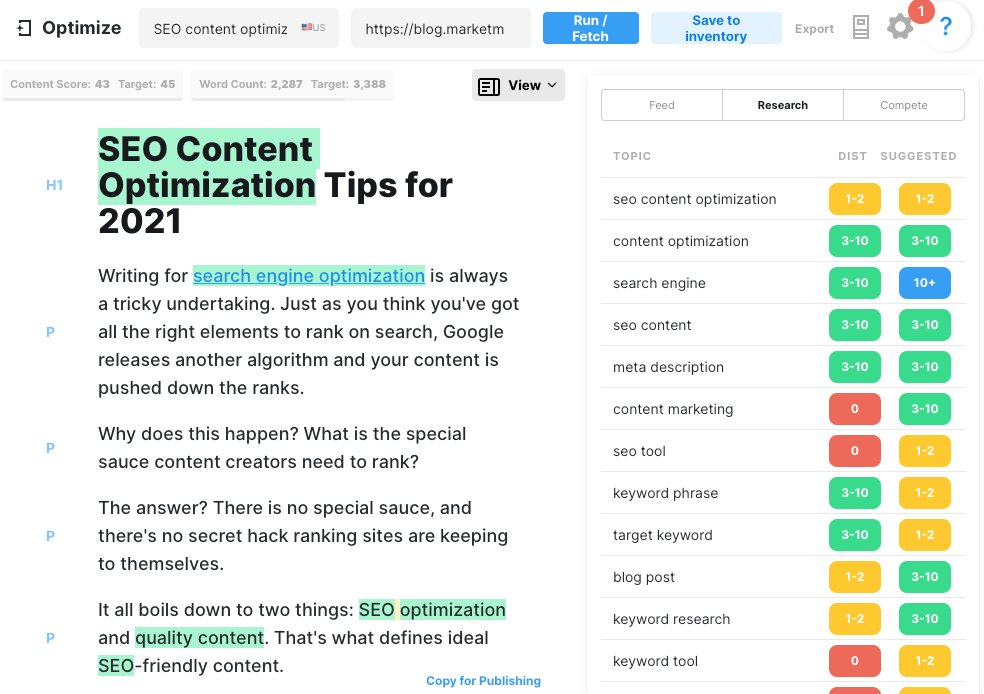
Conduct competitive content analysis
Wondering if you are using the right language? MarketMuse’s heat map lets you see what competing manufacturers are saying.
Just enter a topic and it will create a model based on its analysis of thousands of pages of documents. Then it compares the top 20 results in Google to see their usage of those terms. This enables you to identify topics you absolutely must talk about, because everyone else is, plus other related topics which could be covered to differentiate your content from the competition.
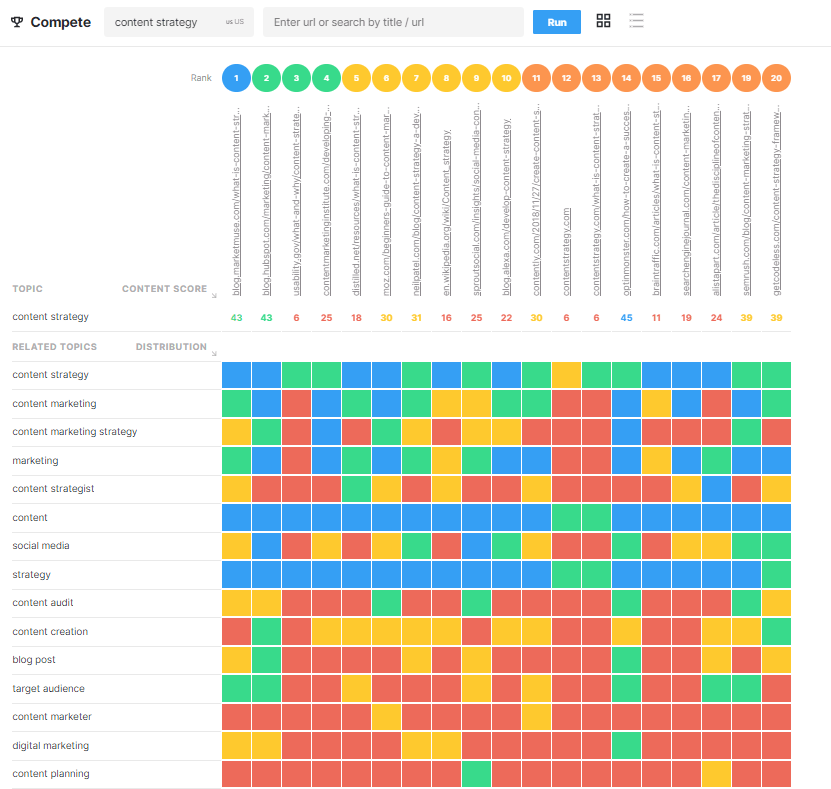
Off-Page SEO
Let’s talk about the easiest type of link building – the ones you create yourself on your own content connecting to other internal pages and valuable external resources. They’re effective for several reasons:
- Connecting to other pages on your site creates topic clusters that contribute to your authority. Visitors to your site will appreciate it and so will Google.
- Internal links can help move visitors further down the funnel with valuable resources.
- Both Google and your readers expect to see links out to external websites to show you are a part of the ecosystem in your industry. Not linking out creates a negative perception of your industry influence.
When linking out to other pages, whether on your site or externally, use appropriate anchor text and don’t link out to your competitors in the search engine results pages. MarketMuse Connect can help with this.

It analyzes your site to find the most appropriate content to link to, including anchor text that it draws from the content model.
Take Advantage of the Title Tag and Meta Description
Every page features additional data that describes the contents of the page. Known as metadata, two of the most most important components are the title tag and description.

The title needs to accurately reflect the contents of the page (for search engines) yet simultaneously be engaging (for humans). Think of the title as enabling a search engine to quickly bucket content prior to ranking for a specific term. So a page about ‘injection molding’ won’t even be considered when looking to rank content about ‘how to grow tomatoes.’ Although search engines rank, it’s humans that read the result, hopefully visit your page and end up a paying customer. So you want a title that creates interest.
While the meta description isn’t part of Google’s ranking criteria, it does factor into whether a Searcher clicks on an entry and visits a page in the search results. Although Google rewrites meta descriptions 70% of the time, it’s still worth creating accurate and compelling ones. Here are Google’s best practices for creating quality descriptions.
Clean up Internal Redirects and Broken Links
Sometimes content gets deleted – it could be a page, a video, an image, whatever. When that happens, any links pointing to that item are now broken and they don’t work anymore. That experience is not appreciated by either humans or search engines. The way to deal with this is to set up a redirect that points any incoming links to the new piece of content. Redirects are very common and are a simple way to deal with this situation as it often requires too much effort to update all the incoming links versus setting up one redirect.
But what if that new piece of content gets deleted? You could set up another redirect that redirects the existing redirect. But going forward in this manner creates too many levels of redirects. So it’s best to keep things clean and update your original redirect.
Tracking with Google Search Console and Google Analytics
These are two of the most common tools used by SEO experts and they are free. Google Search Console “helps you monitor, maintain, and troubleshoot your site’s presence in Google Search results.” Google Analytics collects data from your site and provides insight into search traffic including where it comes from and how visitors interact with your website pages.
Set up Your Google Business Profile
A Google Business Profile helps a manufacturing business maintain its online presence across Google. Creating a business profile is free but you’ll need to create a free Google My Business account for that profile first. You can also use Google my Business for local SEO, primarily maintaining the quality and accuracy of information about your company while building trust (in the form of reviews and responses). Here’s an example of what a business profile looks like on a desktop search for a company name (a branded search).
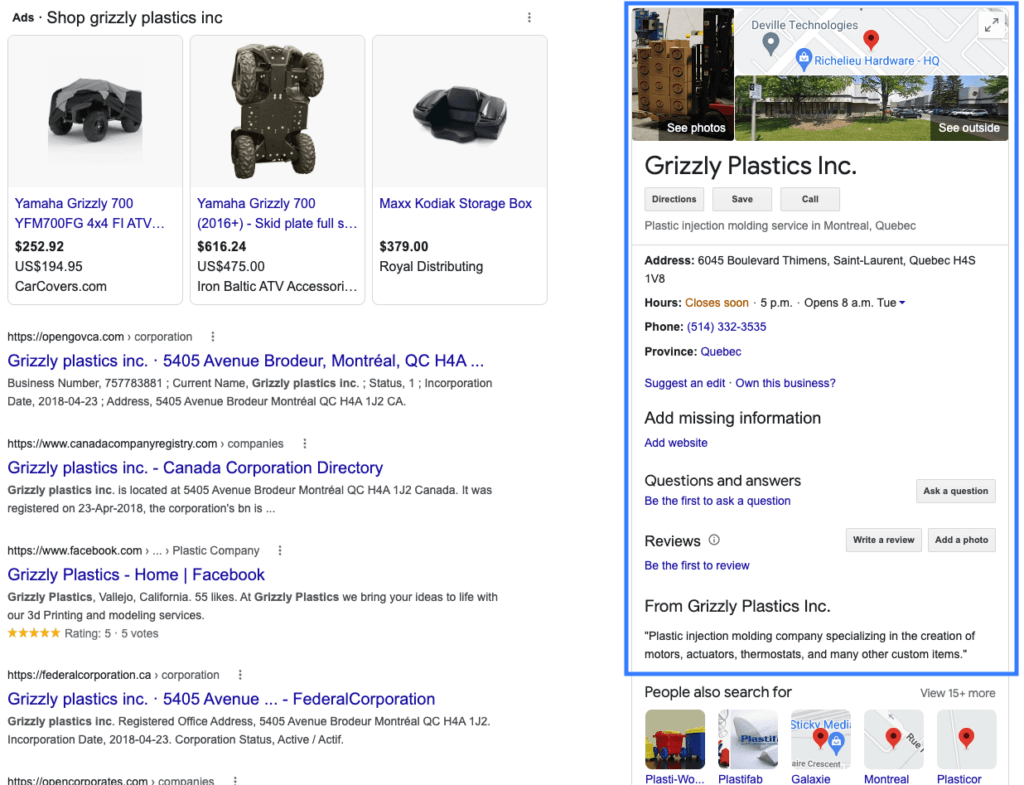
Use Google My Business to create a profile that shows up in searches for your company. The profile is a combination of information you supply and user generated content in the form of reviews and questions.
Create a Favorable Brand SERP Experience
Your brand SERP is what people see in the search results when they Google your manufacturing business. Brand SERP expert Jason Barnard calls it “your new business card, an honest critique of your content strategy and a reflection of your brand’s digital ecosystem.” There are a few things you can do to optimize your brand SERP based on particular features of the search engine results page.
A Knowledge Panel can also appear during a search for your company name. It’s different from a Google Business Profile in that you don’t have direct control over it. But often you can trigger one by making sure to appear in (link with) the most important and authoritative sources for your industry – ones with high trust and notability signals.

Consistently publishing to your social media channels may trigger SERP features like the Twitter box.

Regularly publish content on your company’s official Twitter stream and YouTube channel to trigger the respective box in Google’s Search engine results page (SERP) for your company.
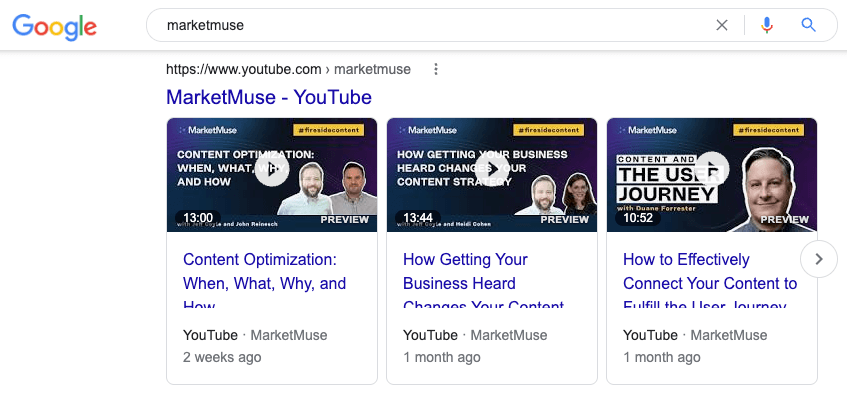
A few other things that can help with brand SERP. Answering common questions about your brand can trigger the People Also Ask feature in the SERP. Google may include sitewide links (to popular pages) along with your brand snippet – think about this when building out your site architecture. Also, consider using Google Ads to bid on your own term. It’s ridiculously inexpensive, you’ll get the top spot, and reduce the impact of any competitive ads.
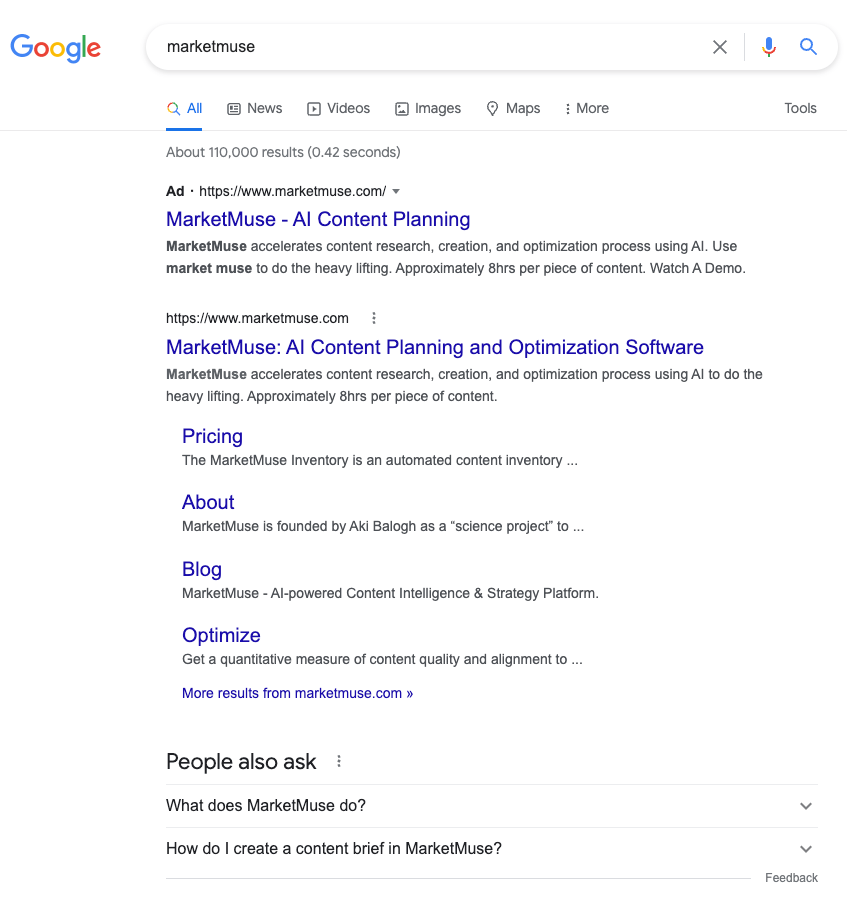
Takeaways
SEO success is the result of many different tactics applied consistently according to a well-devised plan. Ultimately, you want to convert that SEO website traffic into either leads or direct sales, whichever is most appropriate. To do that, you’ll need to serve website visitors with the right content at the right time.
What you should do now
When you’re ready… here are 3 ways we can help you publish better content, faster:
- Book time with MarketMuse Schedule a live demo with one of our strategists to see how MarketMuse can help your team reach their content goals.
- If you’d like to learn how to create better content faster, visit our blog. It’s full of resources to help scale content.
- If you know another marketer who’d enjoy reading this page, share it with them via email, LinkedIn, Twitter, or Facebook.
Stephen leads the content strategy blog for MarketMuse, an AI-powered Content Intelligence and Strategy Platform. You can connect with him on social or his personal blog.